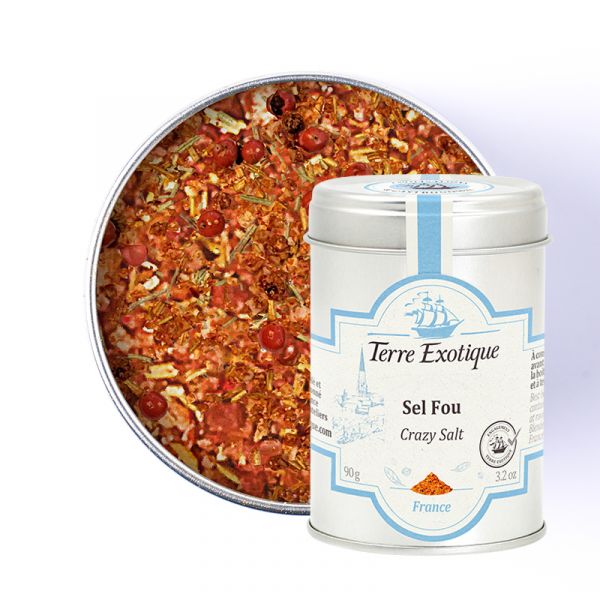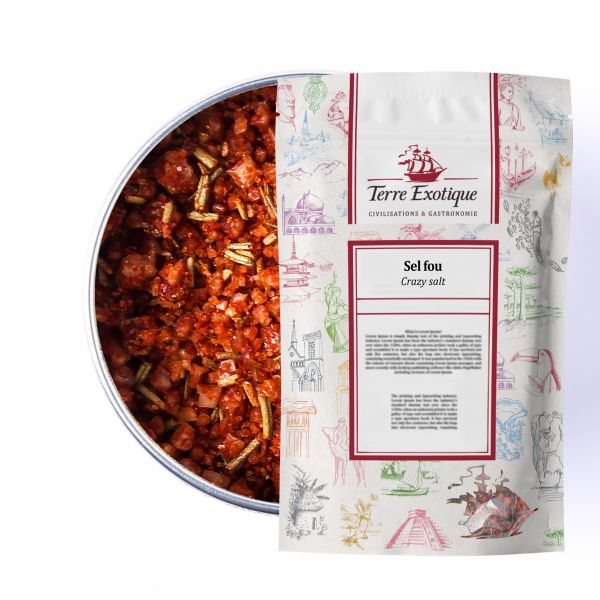





Where to use Crazy salt
The delicate full
flavours of this Crazy salt are perfect for seasoning your dishes or simply
as a table salt to amaze your guests.
Use it in dry marinades,
stocks, on grilled meat or in salads.
How to get the best
from your Crazy salt
Our recipe ideas for
Crazy salt:
·
Crazy butter: add between 2 and 5 grammes of Crazy salt to your butter.
Ideal for spreading on blinis with smoked salmon;
·
Crazy marinated white fish: marinate your fish in the juice of 2
lemons with olive oil and a few pinches of Crazy salt for 4 to 5 hours, then cook
on the barbeque;
·
Crazy stock: add 3 pinches of Crazy salt to your stock for an original
spicy twist;
·
Crazy marinated beef: rub your meat with a mix of Crazy salt and olive
oil and leave to marinate for 4 to 5 hours;
·
Crazy baked potatoes: sprinkle a tablespoon of Crazy salt over your potatoes
before baking in the oven;
·
Crazy roast chicken: sprinkle your chicken with Crazy salt before roasting;
·
Crazy grilled beef ribs: sprinkle your beef with a few pinches of Crazy
salt just before serving and enjoy.
Grilled sea bass with Crazy
salt
Ingredients
2 sea bass;
4 tablespoons Crazy
salt.
Method
Sprinkle the bottom
of an oven-ready dish with 2 tablespoons of Crazy salt then place your sea
bass on top. Then cover the fish with another layer of the remaining 2 tablespoons
of Crazy salt and wet with water so that the salt forms a crust.
Roast in the oven
for 35 minutes at 180°C and serve immediately with mashed potato or parsnip.
Crazy
salt is for connoisseurs of subtle, spicy and delicate aromas
This mix brings together delicious
sweet and savoury flavours. Crazy salt is slightly spicy, releasing mild
herby and peppery aromas making it perfect for all your daily dishes.
What are the ingredients of Terre Exotique’s Crazy salt?
Crazy salt is a
speciality from Guerande and Île de Ré off the West coast of France. It is
also called “Devil’s salt” due to its bright red colour and its hot
spiciness. Our recipe uses coarse sea salt from Île de Ré, paprika, rosemary,
pink berries and Cayenne pepper. This spicy salt can be used in all your
daily dishes. Use it as your secret ingredient to keep your guests guessing!
The coarse sea salt from
Île de Ré is harvested by hand and gets its colour from the clay salt ponds.
Paprika, which is emblematic
of the Zitava River region in Slovakia, gives the mix a gentle slightly sweet
flavour and its vibrant red colour.
Rosemary or Rosmarinus officinalis grows on bushes
in the wild all around the Mediterranean. In Latin it is called Rosmarinus
which means sea dew.
Pink berry or pepper
pink was called Bourbon Pepper in the 17th century. Pink berry is the
fruit of the Schinus terebinthifolia which
grows in la Reunion, and releases sweet and peppery flavours. These berries
are sorted by local Malagasy women, who only choose the reddest and ripest
berries for their strong aromatic flavours.
Cayenne pepper is also
called Pili-pili, and is one of the hottest chillies in the world. It is harvested
in Uganda. Its scientific name is Capsicum
frutescens and it is part of the
Solanaceae family.
The mysterious
beginnings of Crazy salt
An island recipe
We don’t really know for sure
where Crazy salt all started. We do know though that it was probably the salt
workers in Île de Ré who created it and then it spread to Guerande. The salt
workers, or salt farmers, harvest the salt from salty marshes. It is thought
that the salt workers from Île de Ré started adding herbs and spices to their
salt to diversify their wares and attract new customers.
| Allergen | Absence |
|---|---|
| Native country | FRANCE |
| Ingredients | salt from île de Ré 87%, paprika, rosemary, pink peppercorn, Cayenne |
| chili in powder. | |
| Nutritional Info | VN Energie pour 100 g (energy for 100g) : 213.9 kJ / 51.2 kcal VN Matière grasse (fat) : 2.3 g Dont acide gras saturés (of which saturated fat) : 0.6 g VN Glucides (carbohydrate) : 5.1 g Dont sucres (of which sugars) : 1.1 g VN Protéines (protein) : 1.3 g Vn Sel (salt) : 79.2 g |
| TRACES EVENTUELLES D'ALLERGÈNES | céleri, sésame, moutarde, fruits à coques. |
 Français
Français 